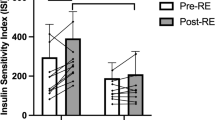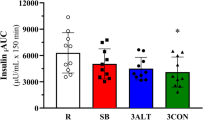Abstract
Background: Regular resistance exercise completed for a number of weeks has been shown to increase insulin sensitivity and reduce the risk of diabetes-related complications. However, the acute responses to resistance exercise have not been adequately investigated in relation to training frequency. Aim: To investigate the changes to insulin sensitivity in apparently healthy individuals following a single session of unaccustomed resistance exercise. Subjects and methods: Ten sedentary, apparently healthy individuals performed a baseline oral glucose tolerance test and maximal strength testing. Participants then performed a single session of moderate-high intensity resistance exercise which was followed by 4 consecutive days of oral glucose tolerance testing, for which participants replicated their initial diet. Mean estimated insulin sensitivity change scores from baseline values and their 95% confidence intervals were compared to the previously determined values for a clinically meaningful change. Results: Two participants were identified as having hyperinsulinemia and their data were therefore removed from the main analysis. There was a clinically meaningful increase in insulin response (mean >7237 pmol·I−1·120 min−1) on all days following the exercise session and a clinically meaningful increase in glucose response (mean >81 mmol·I−1·120 min−1) on only the 3rd day following exercise. These changes suggest a potentially adverse short-term effect. Additionally, the 2 individuals with hyperinsulinemia displayed more extreme results. Conclusion: These results suggest that insulin sensitivity may be impaired following a single session of unaccustomed resistance exercise for approximately 4 days in healthy untrained, older individuals. Further research is required for individuals with hyperinsulinemia.
Similar content being viewed by others
References
DeFronzo RA. Pathogenesis of type 2 diabetes mellitus. Med Clin North Am 2004, 88: 787–835, ix.
Hotamisligil GS. Inflammation and metabolic disorders. Nature 2006, 444: 860–7.
Johnson RJ, Segal MS, Sautin Y, et al. Potential role of sugar (fructose) in the epidemic of hypertension, obesity and the metabolic syndrome, diabetes, kidney disease, and cardiovascular disease. Am J Clin Nutr 2007, 86: 899–906.
Nguyen S, Lustig RH. Just a spoonful of sugar helps the blood pressure go up. Expert Rev Cardiovasc Ther 2010, 8: 1497–9.
Snowling NJ, Hopkins WG. Effects of different modes of exercise training on glucose control and risk factors for complications in type 2 diabetic patients: a meta-analysis. Diabetes Care 2006, 29: 2518–27.
Williams MA, Haskell WL, Ades PA, et al; American Heart Association Council on Clinical Cardiology; American Heart Association Council on Nutrition, Physical Activity, and Metabolism. Resistance exercise in individuals with and without cardiovascular disease: 2007 update: a scientific statement from the American Heart Association Council on Clinical Cardiology and Council on Nutrition, Physical Activity, and Metabolism. Circulation 2007, 116: 572–84.
Gordon BA, Benson AC, Bird SR, Fraser SF. Resistance training improves metabolic health in type 2 diabetes: a systematic review. Diabetes Res Clin Pract 2009, 83: 157–75.
Chapman J, Garvin AW, Ward A, Cartee GD. Unaltered insulin sensitivity after resistance exercise bout by postmenopausal women. Med Sci Sports Exerc 2002, 34: 936–41.
Howlett KF, Sakamoto K, Garnham A, Cameron-Smith D, Hargreaves M. Resistance exercise and insulin regulate AS160 and interaction with 14-3-3 in human skeletal muscle. Diabetes 2007, 56: 1608–14.
Luebbers PE, Potteiger JA, Warren BJ, Clore JN, Jennings C, Bond DS. Glucose uptake after resistance training of different intensities but of equal work volume. J Strength Cond Res 2008, 22: 1094–100.
Fenicchia LM, Kanaley JA, Azevedo JL Jr, et al. Influence of resistance exercise training on glucose control in women with type 2 diabetes. Metabolism 2004, 53: 284–9.
Fluckey JD, Hickey MS, Brambrink JK, Hart KK, Alexander K, Craig BW. Effects of resistance exercise on glucose tolerance in normal and glucose-intolerant subjects. J Appl Physiol 1994, 77: 1087–92.
Koopman R, Manders RJ, Zorenc AH, et al. A single session of resistance exercise enhances insulin sensitivity for at least 24 h in healthy men. Eur J Appl Physiol 2005, 94: 180–7.
King DS, Feltmeyer TL, Baldus PJ, Sharp RL, Nespor J. Effects of eccentric exercise on insulin secretion and action in humans. J Appl Physiol 1993, 75: 2151–6.
Trost SG, Owen N, Bauman AE, Sallis JF, Brown W. Correlates of adults’ participation in physical activity: review and update. Med Sci Sports Exerc 2002, 34: 1996–2001.
World Health Organization. Definition and diagnosis of diabetes mellitus and intermediate hyperglycemia: A report of a WHO/IDF consultation. Geneva, Switzerland: WHO Document Production Services, 2006.
Craig CL, Marshall AL, Sjöström M, et al. International physical activity questionnaire: 12-country reliability and validity. Med Sci Sports Exerc 2003, 35: 1381–95.
Mari A, Pacini G, Murphy E, Ludvik B, Nolan JJ. A model-based method for assessing insulin sensitivity from the oral glucose tolerance test. Diabetes Care 2001, 24: 539–48.
Tabachnick BG, Fidell LS. Using multivariate statistics. 4th ed. Needham Heights, MA, USA: Allyn & Bacon, 2001.
Andersen E, Høstmark AT. Effect of a single bout of resistance exercise on postprandial glucose and insulin response the next day in healthy, strength-trained men. J Strength Cond Res 2007, 21: 487–91.
Braith RW, Stewart KJ. Resistance exercise training: its role in the prevention of cardiovascular disease. Circulation 2006, 113: 2642–50.
Kirwan JP, del Aguila LF. Insulin signalling, exercise and cellular integrity. Biochem Soc Trans 2003, 31: 1281–5.
King DS, Baldus PJ, Sharp RL, Kesl LD, Feltmeyer TL, Riddle MS. Time course for exercise-induced alterations in insulin action and glucose tolerance in middle-aged people. J Appl Physiol 1995, 78: 17–22.
Miller JP, Pratley RE, Goldberg AP, et al. Strength training increases insulin action in healthy 50- to 65-yr-old men. J Appl Physiol 1994, 77: 1122–7.
Author information
Authors and Affiliations
Corresponding author
Rights and permissions
About this article
Cite this article
Gordon, B.A., Fraser, S.F., Bird, S.R. et al. Insulin sensitivity in response to a single resistance exercise session in apparently healthy individuals. J Endocrinol Invest 35, 665–669 (2012). https://doi.org/10.3275/7972
Accepted:
Published:
Issue Date:
DOI: https://doi.org/10.3275/7972




